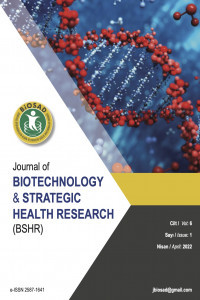Konjenital Kalp cerrahisinde Uzaktan İskemik Önkoşullama İle Miyokardiyal Koruma: Bekleneni Sağlıyor Mu?
İskemik Önkoşullama, Konjenital Kalp Defekti, Miyokardiyal Koruma
Myocardial Protection With Remote Ischemic Preconditioning In Congenital Heart Surgery: Does It Deliver What Is Expected?
___
- Referans1 Butts RJ, Scheurer MA, Atz AM, Zyblewski SC, Hulsey TC, Bradley SM, Graham EM. Comparison of the maximum vasoactive inotropic score and low cardiac output syndrome as markers of early postoperative outcomes after neonatal cardiac surgery. Pediatr Cardiol. 2012 Apr;33(4):633-8
- Referans2 Graham EM, Atz AM, Butts RJ, Baker NL, Zyblewski SC, Deardorff RL, et al. Standardized preoperative corticosteroid treatment in neonates undergoing cardiac surgery: results from a randomized trial. J Thorac Cardiovasc Surg. 2011; 142(6):1523–1529.
- Referans3 Hoffman TM, Wernovsky G, Atz AM, Kulik TJ, Nelson DP, Chang AC, et al. Efficacy and safety of milrinone in preventing low cardiac output syndrome in infants and children after corrective surgery for congenital heart disease. Circulation. 2003; 107(7):996–1002.
- Referans4 Kulik TJ, Moler FW, Palmisano JM, Custer JR, Mosca RS, Bove EL, et al. Outcome-associated factors in pediatric patients treated with extracorporeal membrane oxygenator after cardiac surgery. Circulation. 1996; 94(9 Suppl): II63–II68.
- Referans5 Mosca MS, Narotsky DL, Mochari-Greenberger H, Liao M, Mongero L, Beck J, Bacchetta M. Duration of conventional cardiopulmonary resuscitation before extracorporeal cardiopulmonary resuscitation and survival among adult cardiac arrest patients. Perfusion. 2016 Apr;31(3):200-6.
- Referans6 Meert KL, Delius R, Slomine BS, Christensen JR, Page K, Holubkov R, Dean JM, Moler FW; Therapeutic Hypothermia after Pediatric Cardiac Arrest Trial Investigators. One-Year Survival and Neurologic Outcomes After Pediatric Open-Chest Cardiopulmonary Resuscitation. Ann Thorac Surg. 2019 May;107(5):1441-1446.
- Referans7 Sies H. Biochemistry of oxidative stress. Angewandte Chemie 25: 1058–1071, 1986
- Referans8 Murry CE, Jennings RB, Reimer KA. Preconditioning with ischemia: a delay of lethal cell injury in ischemic myocardium. Circulation 1986; 74:1124-36
- Referans9 Lieberthal W, Wolf EF, Rennke HG, Valeri CR, Levinsky NG. Renal ischemia and reperfusion impair endothelium-dependent vascular relaxation. Am J Physiol. 1989 May;256(5 Pt 2): F894-900.
- Referans10 Pantke U, Volk T, Schmutzler M, Kox WJ, Sitte N, and Grune T. Oxidized proteins as a marker of oxidative stress during coronary heart surgery. Free Radic Biol Med 27: 1080–1086, 1999
- Referans11 WHO. Biomarkers in Risk assessment: Validity and Validation. Geneva: WHO, 2001
- Referans12 Fattman CL. Schaefer LM. Oury TD. Extracellular superoxide dismutase in biology and medicine. Free Radic Biol Med. 2003; 35:236–256.
- Referans13 Fukai T. Folz RJ. Landmesser U. Harrison DG. Extracellular superoxide dismutase and cardiovascular disease. Cardiovasc Res. 2002; 55:239–249.
- Referans14 Qin Z. Reszka KJ. Fukai T. Weintraub NL. Extracellular superoxide dismutase (ecSOD) in vascular biology: an update on exogenous gene transfer and endogenous regulators of ecSOD. Transl Res. 2008; 151:68–78.
- Referans15 Gaies, M. G., Gurney, J. G., Yen, A. H., Napoli, M. L., Gajarski, R. J., Ohye, R. G., … Hirsch, J. C. (2010). Vasoactive–inotropic score as a predictor of morbidity and mortality in infants after cardiopulmonary bypass*. Pediatric Critical Care Medicine, 11(2), 234–238.
- Referans16 Jacobs, J. P., Jacobs, M. L., Maruszewski, B., Lacour-Gayet, F. G., Tchervenkov, C. I., Tobota, Z., … Mavroudis, C. (2012). Initial application in the EACTS and STS Congenital Heart Surgery Databases of an empirically derived methodology of complexity adjustment to evaluate surgical case mix and results. European Journal of Cardio-Thoracic Surgery, 42(5), 775–780.
- Referans17 Esterbauer H, Schaur RJ, and Zollner H. Chemistry and biochemistry of 4-hydroxynonenal, malonaldehyde and related aldehydes. Free Radic Biol Med 11: 81–128, 1991
- Referans18 Frijhoff J, Winyard PG, Zarkovic N, Davies SS, Stocker R, Cheng D, Knight AR, Taylor EL, Oettrich J, Ruskovska T, Gasparovic AC, Cuadrado A, Weber D, Poulsen HE, Grune T, Schmidt HH, Ghezzi P. Clinical Relevance of Biomarkers of Oxidative Stress. Antioxid Redox Signal. 2015 Nov 10;23(14):1144-70.
- Referans19 Miao, L., & St Clair, D. K. (2009). Regulation of superoxide dismutase genes: implications in disease. Free radical biology & medicine, 47(4), 344–356.
- Referans20 Elroy-Stein O. Bernstein Y. Groner Y. Overproduction of human Cu/Zn-superoxide dismutase in transfected cells: extenuation of paraquat-mediated cytotoxicity and enhancement of lipid peroxidation. EMBO J. 1986; 5:615–622.
- Referans21 Epstein CJ. Avraham KB. Lovett M. Smith S. Elroy-Stein O. Rotman G. Bry C. Groner Y. Transgenic mice with increased Cu/Zn-superoxide dismutase activity: animal model of dosage effects in Down syndrome. Proc Natl Acad Sci USA. 1987; 84:8044–8048.
- Referans22 Mezzetti A, Di Ilio C, Calafiore AM, Aceto A, Marzio L, Frederici G, Cuccurullo F. Glutathione peroxidase, glutathione reductase, and glutathione transferase activities in the human artery, vein, and heart. J Mol Cell Cardiol. 1990 Sep;22(9):935-8.
- Referans23 Spiteller G. Linoleic acid peroxidation—the dominant lipid peroxidation process in low density lipoprotein—and its relationship to chronic diseases. Chem Phys Lipids 95: 105–162, 1998
- Yayın Aralığı: Yılda 3 Sayı
- Başlangıç: 2017
- Yayıncı: Deneysel, Biyoteknolojik, Klinik ve Stratejik Sağlık Araştırmaları Derneği
Akın ARSLAN, Emir CANTÜRK, Turgut AKSOY
Doğrulama istenen idrarda madde analiz sonuçlarının incelenmesi
Gamze ZENGİN İSPİR, Şerif Bora NAZLI
Buket BADDAL, Aysegul BOSTANCI, Kaya SÜER
Mahmud İSLAM, Ahmed Cihad GENÇ
Mevcut ve Gelişmekte Olan Aşı Teknolojileri; Kısa derleme
Elmas Pınar KAHRAMAN KILBAŞ, Mustafa ALTINDİŞ
SOLUNUM YOLU ÖRNEKLERİNDE İNSAN BOCAVİRUS'Ü SAPTANMASI
Yeliz TANRIVERDİ ÇAYCI, Elif ATEŞ, Demet GÜR VURAL, Kemal BİLGİN, Asuman BIRINCI
